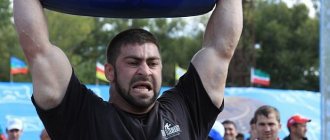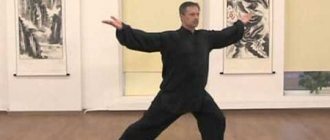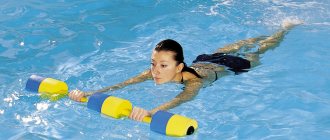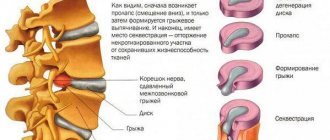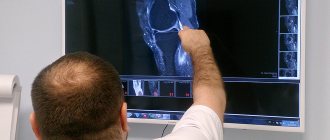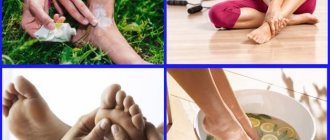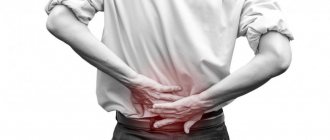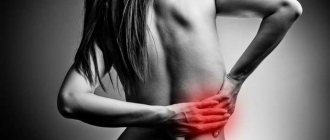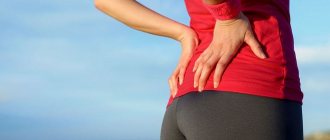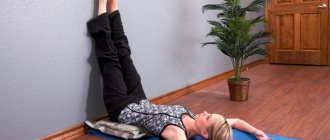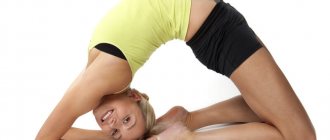Several recommendations to prevent the development of osteochondrosis:
- If cervicothoracic or lumbar pain occurs, a timely and thoughtful examination is necessary. If congenital bone anomalies of the spine are detected, jerking, twisting movements, heavy lifting, and hypothermia should be avoided in the future.
- It is necessary to strengthen the muscles with therapeutic exercises and sports (swimming, walking, cycling).
- It is necessary to choose a profession taking into account the condition of the spine. In cases of predisposition to osteochondrosis, you need to choose a job that does not require prolonged standing, fixed postures of the torso and head, and eliminates chronic microtrauma (vibration).
How to lie down correctly?
A person spends a third of the day in bed, so it is necessary that it is comfortable and its design matches the curves of the spine. It is important to match your body weight to the thickness of the mattress. An obese person will want a bed with a dense mattress, a thin person - a softer one. If a fat person chooses a less dense mattress, the bed will seem too hard to him. On such a bed only your shoulders and hips will rest. A bed that is too soft will not provide support to the body, which will lead to back pain.
The pillow should be low. Place its bottom edge under your neck, and pull the corners over your shoulders. This preserves the cervical curve, and the blood supply to the brain is not disrupted during sleep. For those who are used to sleeping on their side, a hard pillow is suitable; For those sleeping on their back, the average one is suitable; for those who sleep on their stomachs - soft, it will relieve muscle tension. When reading while lying down, do not bend your neck too much; it is better to sit half-sitting so that the load on the cervical vertebrae is minimal.
How to get out of bed in the morning correctly so as not to set yourself up for troubles that may not happen yet? Think positive! When getting out of bed in the morning, you should not bend your torso forward too much. The following exercises are very useful for the spine: Lying on your back and placing your hands on your stomach, take 10-15 slow deep breaths and even slower exhalations, while bending your knees slightly. Stretch both hands up and your heels down, like a cat waking up. Then take a knee-elbow position, arch your back as much as possible, bend over, trying to touch your chest to the bed. Now you can rise up smoothly, leaning on your hands to bend your lower back forward less.
How to sit correctly?
The greatest load on the intervertebral discs is in a sitting position. Change your back position every 15 minutes. Move your arms and legs, stretch, lean your body back. When sitting, your back should be well supported. The best support is the solid back of the chair, slightly tilted back, with a convexity corresponding to the normal curves of the spine.
If the back of the chair is perpendicular to the seat, then a bolster or pillow should be placed under the lumbar curve. When getting up from a chair, always lean on the armrests or, in extreme cases, on the seat. By transferring the load to your arms, you give moments of rest to your spine. Never sit down abruptly, even in a soft chair - this is a blow to the vertebrae, as a result of which the cartilaginous surfaces of the intervertebral joints and discs are worn out, which is harmful at any age. You need to easily and gently lower your body, pointing your head forward and up, relax your neck, keep your spine straight, so that the body weight rests on your feet. Then, as you rise, you can push your body forward, and your spine will keep your head and torso straight. Do not cross your legs - this is harmful not only for the veins, but also for the spine, as it causes pain in the lower back.
The benefits of swimming for a herniated disc
Swimming with a spinal hernia performs several important functions at once. First of all, it is aimed at strengthening the musculoskeletal skeleton: being in good shape, the muscles will more actively resist negative changes. Swimming without performing exercises relaxes and helps to achieve not only physical, but also psychological comfort. If the patient is overweight, then exercise will help you lose unnecessary pounds without putting much effort into it. By the way, the effectiveness of swimming for lumbar hernia is most eloquently demonstrated by the reviews of patients who have already tried this type of rehabilitation therapy on themselves.
How to lift and carry weights correctly?
The main rule: never lift a load with straight legs, tilting your body forward! Squat down with your knees bent and, while lifting the load, keep your torso straight, preferably slightly arched back. This is exactly what weightlifters do. It is very important to hold the load not on outstretched arms, but closer to you, this will significantly reduce the load on the spine. If possible, divide the load into two parts, do not carry the load in one hand, it is better - equally in both.
Learn how to pick up children correctly so that communicating with your child does not cause you negative emotions due to back pain. Sit down with your knees bent, take the baby, hold him to your chest and only then, keeping your torso straight, straighten your knees. When lifting weights, avoid turning your torso at the same time. This combination of movements is the most common cause of “lumbago”. When carrying a load, the body should be as straight, natural, and free as possible.
Harmful physical activity on the spine: consequences and the ability to avoid them
It is worth noting that pain in the spine does not always indicate problems with it. Often the cause can be diseases of the internal organs. Then you need to pay attention directly to them. Eg:
- The cause of neck pain can be malfunctions of the liver and gallbladder.
- Unpleasant sensations in the area of the left shoulder blade - the heart reminds of itself.
- Ulcers of the stomach and duodenum cause pain along the spine and in its lower thoracic region.
- Lower back pain does not always signal radiculitis. The problem may be disease of the kidneys, bladder, intestines and female reproductive organs.
You need to contact a specialist if:
- Discomfort occurs constantly and lasts a long time, while massage, gymnastics and specialized ointments do not bring results.
- Blood pressure rises, pulse quickens.
- It is painful to relieve oneself, fever and muscle spasms appear.
Physical activity that has a negative effect on the spine
- Lifting heavy objects without bending the knees. This also includes the load on one hand followed by moving the load to one side. Then the discs of the spine shift and pinch the nerve.
- Any kind of exercise on uneven bars, horizontal bars, followed by jumping onto the asphalt or floor without using, for example, mattresses. Such tricks are especially dangerous for hernias.
- Performing exercises, where exercises are done abruptly.
- Performing gymnastic exercises without properly warming up the muscles.
- Exercises in which the emphasis is on only one leg. Somersaults with incorrect technique and on a hard surface.
- Any sudden head movements. Often, during prolonged sitting, a person likes to twist his neck until it crunches. Usually the exercise is performed sharply. You can't do that! And even more so when adjusting the vertebrae in another person’s neck.
- Incorrect running technique.
How to sleep properly to avoid spinal pain?
The “lying down” position has long been noted as the most favorable for the spine. Therefore, during sleep it becomes possible to relieve excess stress. But just lying down is not enough. You need to follow some rules. Remember that the pillow must be true to size. That is, during sleep, a person’s neck should be the beginning of the spine line. Sleeping on your stomach is not recommended at all. In this case, a lot of pressure is created on the neck and chest area, which, in turn, leads to increased work of the heart.
Sleeping on your back is less harmful, but also not safe. If you are used to sleeping like this, then place a small pillow or other object in the form of a cushion under your knees.
The correct position is to sleep on your side. Especially if you are worried about pain. There should be a small pillow between your knees. For osteochondrosis and radiculitis, straighten the lower leg, bend the upper leg, and also place a bolster.
Rules for lifting weights during physical work
There are situations in which excessive lifting cannot be avoided. This can be either routine work or periodic work, for example, during home renovations. How to act so as not to harm yourself?
- Carrying a load when turning your body is prohibited! Turn your whole body towards the object, grab it, and only then drag it to the desired place. This way you will prevent curvature of the spine
. - Remember to bend your knees during your first pulls. The ideal option is to sit down a little.
- Distribute the load. Lift with both hands whenever possible. As a last resort, change hands more often.
- Bring the weight as close to you as possible. This will reduce the load on the musculoskeletal system significantly.
- Save the sharpening for later. All movements are soft and smooth. Especially when you are transporting heavy items.
- If you love to garden or garden, then lay a blanket or old clothes on the ground and kneel while cutting grass or harvesting crops. You should not perform work on straightened legs or bent knees.
- Do exercises in the morning. And before any physical activity, warm up your muscles again. Again, smooth and careful movements are needed.
- Take a break every half hour. It is not at all necessary to take a “standing” or “lying” position. Do some physical exercise.
Reducing the load on the musculoskeletal system
The simplest and most accessible way, as already described above, is to take a “lying” position. A small pillow is placed under the lower back, and a bolster is placed under the knees. Lying on your back, if you don’t put anything under your lower back, will not give the desired result, but, on the contrary, will create more pressure on this area.
To maximize the benefits of rest, take a medium towel and roll it tightly. Lay a rug on the floor, lie down, and place the rolled cloth strictly under your lower back. Straighten your arms and place them behind your head: palms should look down, touch with your little fingers. Now the legs: toes - together, heels - apart. In this case, the legs are spread approximately shoulder width apart. At first glance, it seems that the exercise is beyond your strength and will not bring any effect. But over time you will get used to it.
Do it every day and lie like this for up to 5 minutes. We get out of the situation smoothly. First, we sit down without sudden movements. And then we get to work.
Another option is to get on all fours and be a cat for 2-3 minutes. Move around the house in this position. Stop: Bend and arch your back.
Also, very important! Watch your posture. The back muscles must be strong. This way you will reduce the load not only on the spine, but also on the internal organs, if you are not constantly in a crooked position. And also do a spinal massage
and gymnastics.
Author: K.M.N., Academician of the Russian Academy of Medical Sciences M.A. Bobyr
How to maintain mental comfort - the main condition for maintaining health?
Emotional stress, stress, fear and tension have a very negative effect on the spine. Take care of your good mood and don’t let anyone spoil it. Live joyfully every day and don’t worry unnecessarily about your health. The fear of expecting bad events negatively affects your real life. Be active mentally and physically, greet with gratitude all the events and people that await you in life. Try to go to bed before midnight and get up early in the morning so that your biorhythm corresponds to the laws of nature (the alternation of day and night).
Every morning or evening, rub your body with a towel soaked in water - this will activate blood circulation. If you don't have much free time, rub your hands and feet thoroughly, don't forget about your fingers. Be sure to exercise, walk more. If desired, regularly engage in a health group or individually: aerobics, shaping, yoga and various sports. Housework cannot replace refreshing, invigorating gymnastics, a complex of which can be specially developed for you by a physical therapy instructor, taking into account the characteristics of the statics and dynamics of the spine.
Is it possible to swim with a herniated disc?
Swimming with a hernia of the lumbar spine cannot be called a fashionable innovation - just a few decades ago, medical experts unanimously spoke of its benefits. It is also important to understand that sometimes this sport remains the only one that patients with pathologies of the musculoskeletal system can afford. But if left without physical activity at all, a person will feel much worse, and the disease itself will begin to progress.

